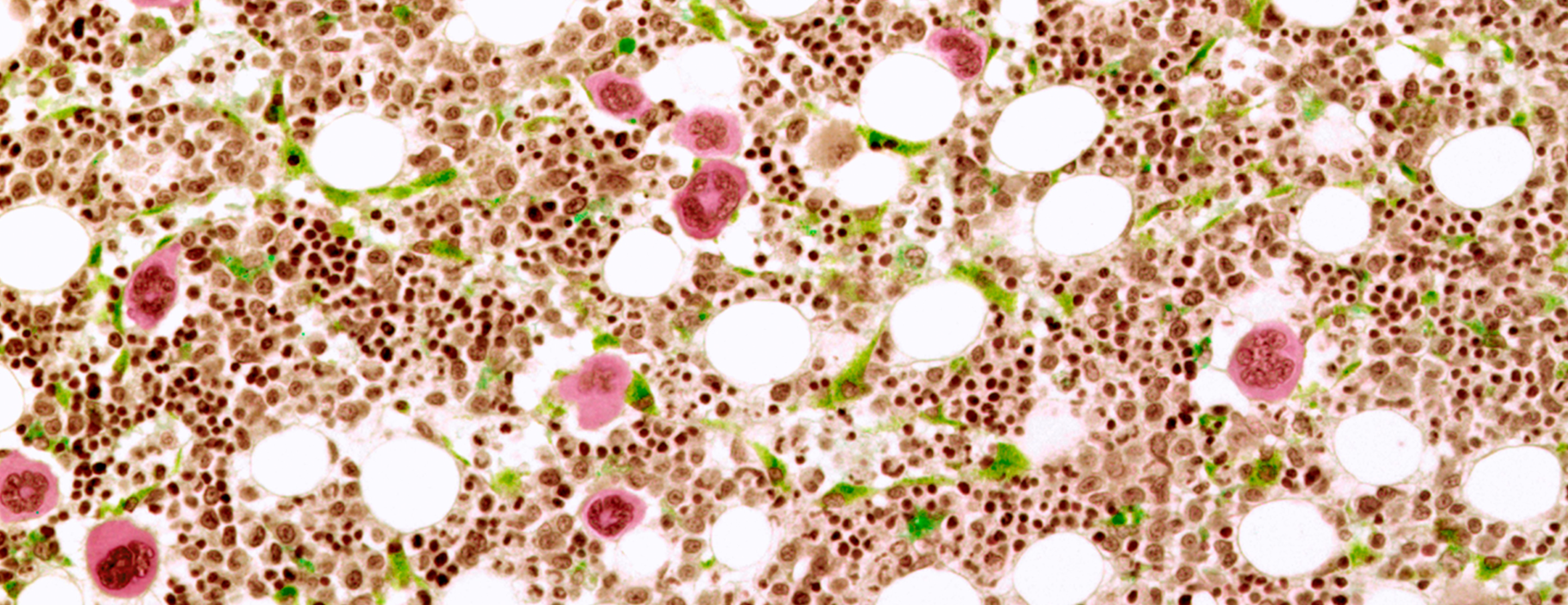
Myelodysplastic syndrome
Definition
Myelodysplastic syndrome is a group of disorders when the blood cells produced in the bone marrow do not mature into healthy cells. This leaves you with fewer healthy blood cells in your body. The blood cells that have matured may not function properly.
Myelodysplastic syndrome (MDS) is a form of cancer. In about a third of people, MDS may develop into
Alternative Names
Myeloid malignancy; Myelodysplastic syndrome; MDS; Preleukemia; Smoldering leukemia; Refractory anemia; Refractory cytopenia
Causes
Stem cells in bone marrow form different types of blood cells. With MDS, the DNA in stem cells becomes damaged. Because the DNA is damaged, the stem cells can’t produce healthy blood cells.
The exact cause of MDS is not known. For most cases, there is no known cause.
Risk factors for MDS include:
- Certain genetic disorders
- Exposure to environmental or industrial chemicals, fertilizers, pesticides, solvents, or heavy metals
- Smoking
Prior cancer treatment increases the risk for MDS. This is called secondary or treatment-related MDS.
- Certain chemotherapy drugs increase the chance of developing MDS. This is a major risk factor.
- Radiation therapy, when used with chemotherapy, increases the risk for MDS even more.
- People who have stem cell transplants may develop MDS because they also receive high doses of chemotherapy.
MDS usually occurs in adults age of 60 years and older. It is more common in men.
Symptoms
Early stage MDS often has no symptoms. MDS is often discovered during other blood tests.
People with very low blood counts often experience symptoms. Symptoms depend on the type of blood cell affected, and they include:
- Weakness or tiredness due to anemia
- Shortness of breath
- Easy bruising and bleeding
- Small red or purple pinpoint dots under the skin caused by bleeding
- Frequent infections and fever
Exams and Tests
People with MDS have a shortage of blood cells. MDS may reduce the number of one or more of these:
- Red blood cells
- White blood cells
- Platelets
The shapes of these cells may also get changed. Your health care provider will perform a
Other tests that may be performed are:
Bone marrow aspiration and biopsy .- Cytochemistry, flow cytometry, immunocytochemistry, and immunophenotyping tests are used to identify and classify specific types of MDS.
- Cytogenetics and fluorescent in situ hybridization (FISH) are used for genetic analysis. Cytogenetic testing can detect translocations and other genetic abnormalities. FISH is used to identify specific changes within chromosomes. Genetic variations may help determine response to treatment.
Some of these tests will help your provider determine what type of MDS you have. This will help your provider plan your treatment.
Your provider may define your MDS as high-risk, intermediate-risk, or low-risk on the basis of:
- The severity of shortage of blood cells in your body
- The kinds of changes in your DNA
- The number of immature white blood cells in your bone marrow
Since there is a risk of MDS developing into AML, regular follow-up with your provider may be required.
Treatment
Your treatment will depend on several factors:
- Whether you are low-risk or high-risk
- The type of MDS you have
- Your age, health, and other conditions you may have, such as diabetes or heart disease
The goal of MDS treatment is to prevent problems due to a shortage of blood cells, infections and bleeding. It may consist of:
Blood transfusion - Drugs that promote the production of blood cells
- Drugs that suppress the immune system
- Low-dose
chemotherapy to improve blood cell counts Stem cell transplantation
Your provider may try one or more treatments to see what your MDS responds to.
Outlook (Prognosis)
The outlook will depend on your type of MDS and severity of symptoms. Your overall health also may affect your chances of recovery. Many people have stable MDS that does not progress into cancer for years, if ever.
About 25% to 30% of people with MDS develop AML.
Possible Complications
MDS complications include:
- Bleeding
- Infections such as pneumonia, gastrointestinal infections, urinary infections
- Acute myeloid leukemia
When to Contact a Medical Professional
Contact your provider if you:
- Feel weak and tired most of the time
- Bruise or bleed easily, have bleeding of the gums or frequent nosebleeds
- You notice red or purple spots of bleeding under the skin
References
Hasserjian RP, Head DR. Myelodysplastic syndromes. In: Jaffe ES, Arber DA, Campo E, Harris NL, Quintanilla-Martinez L, eds. Hematopathology. 2nd ed. Philadelphia PA: Elsevier; 2017:chap 45.
National Cancer Institute website. Myelodysplastic/myeloproliferative neoplasms treatment (PDQ) - health professional version.
Steensma DP, Stone RM. Myelodysplastic syndromes. In: Goldman L, Schafer AI, eds. Goldman-Cecil Medicine. 25th ed. Philadelphia, PA: Elsevier Saunders; 2016:chap 182.
Review Date: 10/16/2017
The information provided herein should not be used during any medical emergency or for the diagnosis or treatment of any medical condition. A licensed physician should be consulted for diagnosis and treatment of any and all medical conditions. Call 911 for all medical emergencies. Links to other sites are provided for information only -- they do not constitute endorsements of those other sites. Copyright ©2019 A.D.A.M., Inc., as modified by University of California San Francisco. Any duplication or distribution of the information contained herein is strictly prohibited.
Information developed by A.D.A.M., Inc. regarding tests and test results may not directly correspond with information provided by UCSF Health. Please discuss with your doctor any questions or concerns you may have.





